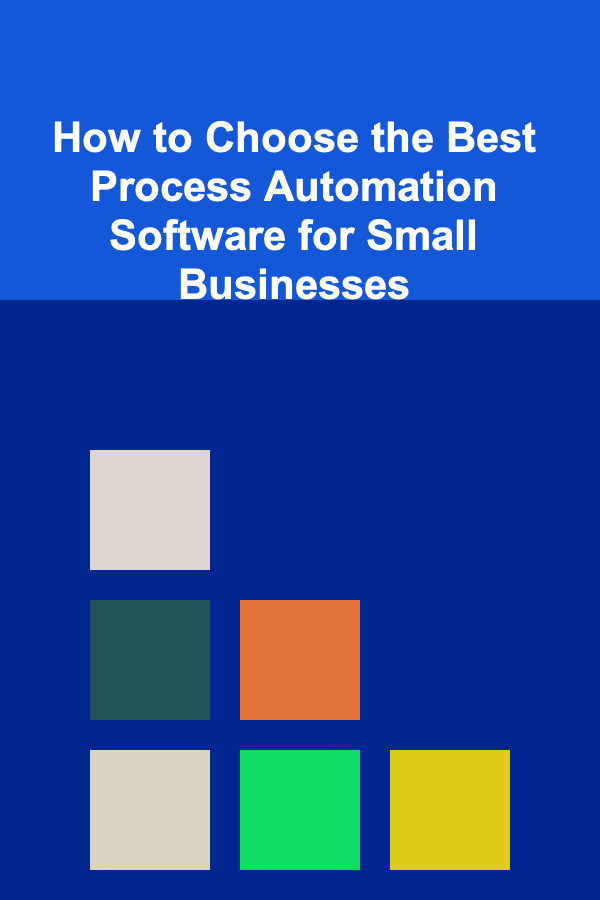
How to Choose the Best Process Automation Software for Small Businesses
ebook include PDF & Audio bundle (Micro Guide)
$12.99$5.99
Limited Time Offer! Order within the next:

In today's fast-paced business environment, efficiency is key. Small businesses, in particular, often face the challenge of managing limited resources while striving to maintain productivity. One of the most effective ways to streamline operations and reduce overhead is through process automation. The right process automation software can help automate repetitive tasks, improve accuracy, and free up time for strategic initiatives.
However, choosing the best process automation software for your small business can be overwhelming, given the numerous options available. In this guide, we'll walk you through the key considerations and steps to choose the best software to meet your unique business needs.
Understanding Process Automation
Before diving into the selection process, it's important to understand what process automation entails. Process automation refers to the use of technology to automate repetitive and routine tasks within a business process. These tasks can range from data entry and document management to customer communication and inventory control. Automating these tasks reduces manual intervention, increases efficiency, and minimizes the likelihood of human error.
For small businesses, process automation can be particularly beneficial in areas such as:
- Customer Relationship Management (CRM): Automating customer data management, email marketing, and follow-up processes.
- Inventory Management: Streamlining order processing, stock level tracking, and reordering.
- Finance and Accounting: Automating invoicing, payroll processing, and financial reporting.
- Marketing: Automating social media posts, lead generation, and content distribution.
- Human Resources: Automating recruitment, employee onboarding, and performance evaluations.
Key Considerations When Choosing Process Automation Software
The best process automation software for your small business will depend on various factors, including your industry, specific business needs, and budget. Here are some critical factors to consider before making your decision.
1. Scalability
One of the most important aspects to consider is scalability. As your business grows, so will the complexity of your processes. Ensure that the software you choose can scale with your business and accommodate future needs. Look for automation tools that can be easily upgraded or integrated with other software as you expand.
2. Ease of Use
For small businesses with limited technical resources, the ease of use of the software is crucial. Look for a platform that is intuitive and doesn't require a steep learning curve. An easy-to-navigate interface will help your team quickly adopt the software, ensuring you get the most out of the tool without the need for extensive training.
3. Integration with Existing Tools
Your small business likely already uses a suite of tools for various tasks (e.g., CRM software, accounting software, email marketing tools). The automation software you choose should integrate seamlessly with these existing tools. Integration will enable you to consolidate your processes and avoid silos, ensuring that your systems work together in harmony.
4. Customization Options
Every business is unique, and your processes may require a certain degree of customization. Some software platforms allow for a high level of customization, enabling you to tailor the automation to your specific needs. Look for software that provides flexibility in setting up workflows, rules, and actions to fit your business's unique processes.
5. Support and Training
Good customer support is essential, especially if you run into any issues during implementation or need help optimizing the software. Check whether the software provider offers training resources, such as tutorials, webinars, or documentation, and consider the quality and availability of customer support. Some providers offer 24/7 support, while others may only be available during business hours.
6. Cost vs. ROI
Small businesses need to be mindful of their budget, but it's essential to view the software as an investment in your business's future. The right process automation software can save your business significant time and money by reducing manual work and improving productivity. However, you should ensure that the cost of the software aligns with your business's budget and the expected return on investment (ROI). Some software providers offer tiered pricing based on features, which can help you choose a solution that fits your current needs and budget.
7. Security and Compliance
Process automation often involves the handling of sensitive data, such as customer information and financial records. Therefore, it's critical to choose software that complies with relevant data protection regulations (e.g., GDPR, HIPAA). Look for software with robust security features, such as encryption, two-factor authentication, and regular data backups.
Steps to Choosing the Best Process Automation Software
Now that you know what to look for, let's go through the steps you can take to choose the best process automation software for your small business.
Step 1: Identify Your Needs and Goals
The first step is to assess your current business processes and identify which areas would benefit the most from automation. Are you struggling with repetitive administrative tasks? Do you need better communication with customers? Or is it a combination of several factors? By pinpointing the areas that need the most attention, you'll be able to narrow down your software options.
Step 2: Research Available Options
Once you have a clear understanding of your needs, start researching available process automation software. Some popular options for small businesses include:
- Zapier: Great for automating workflows across a wide range of apps and tools.
- Integromat: Offers advanced automation features and integrations with a large number of platforms.
- HubSpot: A comprehensive CRM and marketing automation tool that also includes process automation.
- Trello with Butler: Simple but powerful automation within a project management platform.
- Zoho One: A complete suite of business applications with automation capabilities.
Make sure to look at user reviews, case studies, and feature lists to determine which software best suits your business needs.
Step 3: Test the Software
Most process automation software providers offer free trials or demo versions of their platforms. Take advantage of these offerings to test the software and see how it fits with your business processes. During the trial, pay attention to factors like ease of use, integration capabilities, and the ability to automate the tasks you identified earlier.
Step 4: Evaluate Customer Support
Good customer support can make a world of difference, especially if you run into issues during the setup process. Evaluate the level of support offered by the provider. Are they responsive? Do they provide helpful resources? A quick response time can save you time and frustration in the long run.
Step 5: Make the Decision
After thoroughly testing the software and evaluating its features, integrations, and support, it's time to make your decision. Choose the platform that best aligns with your business needs, budget, and goals.
Best Practices for Implementing Process Automation
Once you've chosen the best process automation software for your business, it's time to implement it effectively. Here are some best practices to keep in mind:
- Start Small: Begin by automating one or two key processes. This will help you get comfortable with the software and avoid overwhelming your team with too many changes at once.
- Set Clear Goals: Define measurable goals for your automation initiatives, such as reducing the time spent on manual tasks or improving data accuracy.
- Involve Your Team: Involve your team in the decision-making and implementation process. Their feedback will be invaluable in fine-tuning the automation workflows.
- Monitor Performance: Regularly monitor the performance of your automated processes to ensure that they're working as expected. If you notice inefficiencies, make adjustments as needed.
- Iterate and Improve: Automation is not a one-and-done process. Continuously look for opportunities to improve and expand automation across your business.
Conclusion
Choosing the best process automation software for your small business doesn't have to be an overwhelming task. By assessing your specific needs, evaluating software options, and following a structured implementation plan, you can significantly improve your business efficiency and productivity. The right software will save you time, reduce errors, and help your business scale smoothly. Keep these factors in mind, and you'll be on your way to streamlining your business processes for long-term success.
Reading More From Our Other Websites
- [Home Budget 101] How to Budget with One Income: Tips for Single-Income Households
- [Trail Running Tip 101] Conquering the Peaks: A Beginner's Guide to Trail Marathon Training
- [Home Renovating 101] How to Handle Renovation Stress and Stay Organized
- [Survival Kit 101] Top Items to Include in Your Survival Kit for Home Safety and Comfort
- [Home Storage Solution 101] How to Set Up a Garage Storage System with Shelving and Hooks
- [Home Budget Decorating 101] How to Master Home Design on a Low Budget
- [Gardening 101] How to Organize Your Garden Shed for Maximum Efficiency
- [Home Party Planning 101] How to Set Up a Cozy Indoor Picnic for Your Home Party
- [Sewing Tip 101] How to Sew a Zero‑Waste Capsule Wardrobe from Sustainably Sourced Materials
- [Home Rental Property 101] How to Rent Rentals with a Breakfast Bar for Stylish, Functional Spaces

Generating Passive Income with Deep Learning in the Freelance Market
Read More
How to Reduce Plastic Use in Home Organization
Read More
How to Select the Best Remote Work Tools for Your Needs
Read More
How To Select the Right Lighting for Every Room
Read More
How to Use Storage Ottomans in Your Living Room
Read More
How to Track Variable Expenses for Debt Payoff
Read MoreOther Products

Generating Passive Income with Deep Learning in the Freelance Market
Read More
How to Reduce Plastic Use in Home Organization
Read More
How to Select the Best Remote Work Tools for Your Needs
Read More
How To Select the Right Lighting for Every Room
Read More
How to Use Storage Ottomans in Your Living Room
Read More